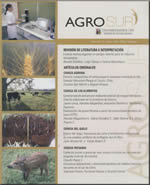Effect of irrigation management, harvesting frequency and nitrogen fertilization on a pasture in Los Ríos Region, Chile
Main Article Content
Abstract
A study was carried out in the property “El Laurel Bajo”, located 2.5 km southwest of La Unión, Chile, between November 1, 2006 and April 1, 2007 to study the effect of irrigation, in combination with two harvesting frequencies and two doses of nitrogen fertilization, on pasture productivity. Dry matter production and forage quality were studied. The pasture corresponded to a mixture of annual and biannual rye grass cultivars, sown at the end of August, 2006. Plots of 3 m x 2 m (6 m2) were used. The study was based on a factorial design of 3 factors (2 x 2 x 2). The first factor was irrigation (with and without); the second factor was fertilization: 150 kg N/ha or 250 kg N/ha and the third factor was cutting frequency: high frequency (every 15 days, simulating grazing) and low frequency (every 45 days, simulating an operation to conserve forage). Irrigation frequency was programmed using the information of an evaporation tank. A 30 mm irrigation rate was applied whenever this height was equivalent to 80% of tank evaporation. The highest yield (average 12,735 kg DM/ ha) was obtained with irrigation, low cutting frequency (45 days) and 250 kg/ha of N fertilization. The lowest yield (average 2,906 kg DM/ha) was without irrigation, high cutting frequency (15 days) and 150 kg/ha of N fertilization. When the seasonal production previous to the study (1,276 kg MS/ha) is added to the data, total productions of 14,011 and 4,182 kg MS/ha were obtained for the greatest and lowest yield, respectively. Regarding the parameters of nutritional quality of treatments, irrigated plots showed lower levels in DM and NDF, compared to plots without irrigation.

